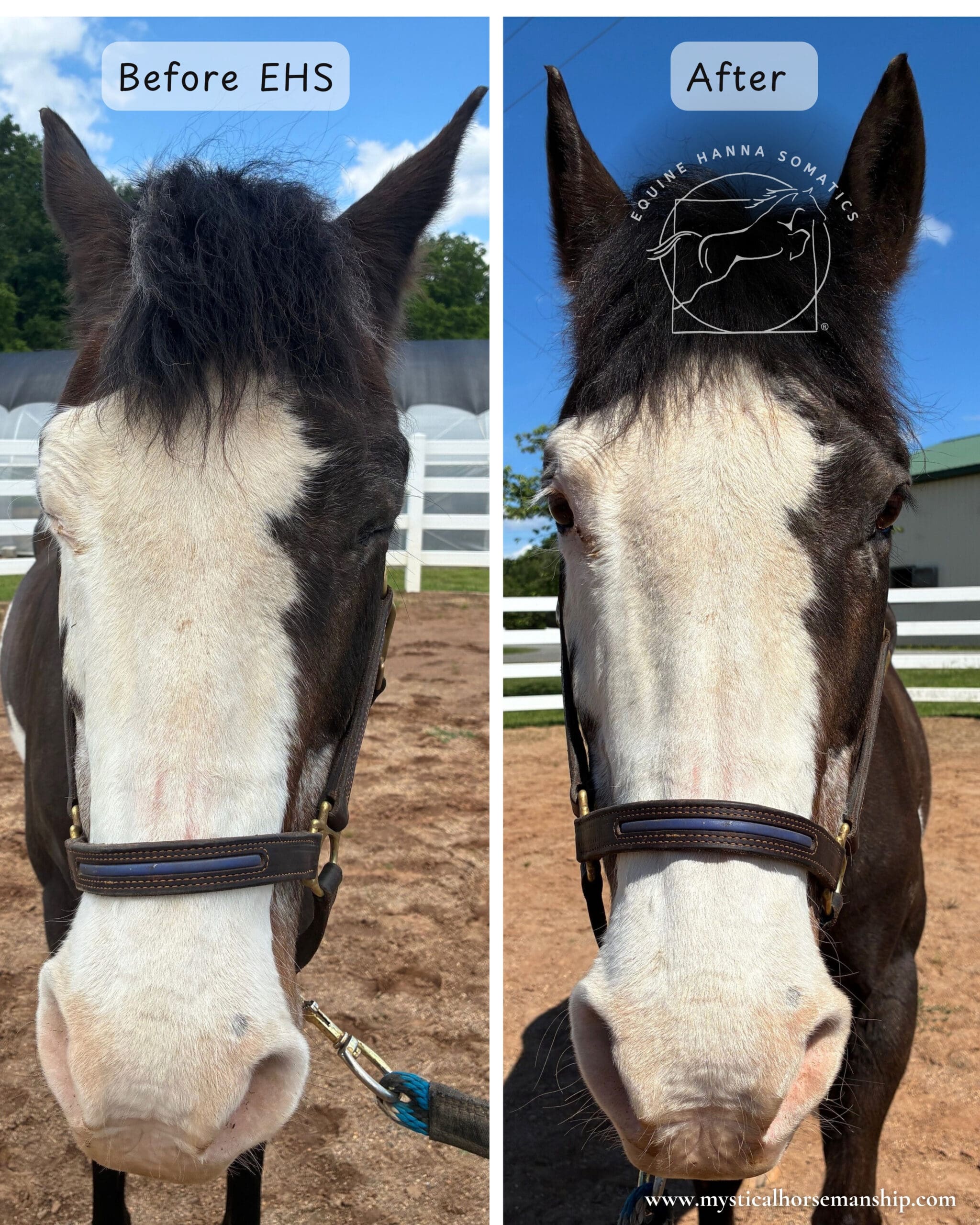Empower Your Horse
Have you ever wondered if you could support your horse in a different way? One that empowers your horse in a way unlike any other bodywork or training methods? What if you didn’t have to do hours of strengthening exercises each week to help your horse improve their posture and movement? What if your horse could do it on their own? Welcome to Equine Hanna Somatics®!
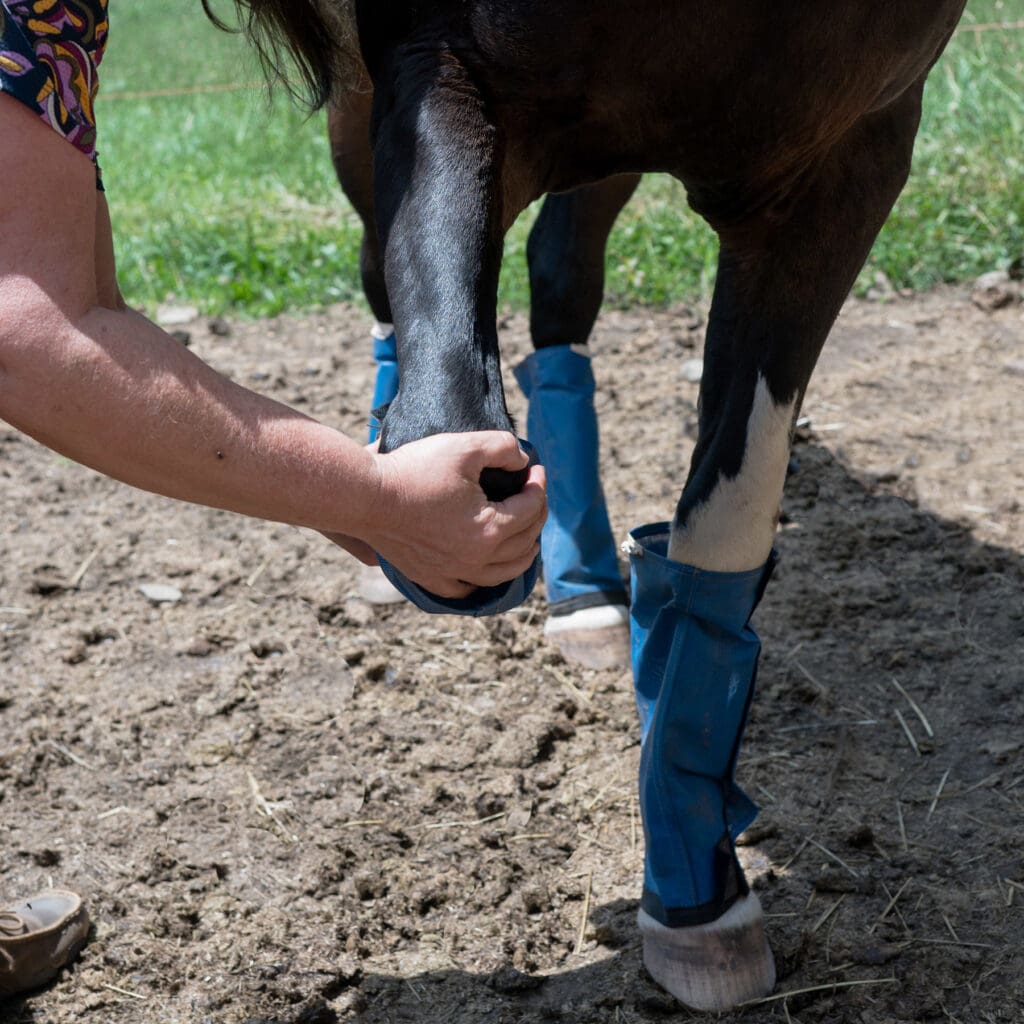
What is Equine Hanna Somatics?
Thomas Hanna initially designed a set of exercises for humans, and Hanna’s wife, Dr. Eleanor Criswell Hanna, later adapted the exercises for horses. For over 25 years, these exercises have been helping horses self-correct their habitual muscle tension so their nervous system can do its job of restoring and maintaining homeostasis and normal neutral posture without doing any stretching, massage, or supportive strengthening work. These exercises are based on the horse’s natural ability to pandiculate.
What is Pandiculation?
Pandiculation is an involuntary natural reflex that helps reset the nervous system. It often looks like stretching, although it is actually muscles contracting. In horses, we often see pandiculation in the following ways:
- A “downward dog” movement
- An upward stretch of the neck
- An extension of the hind leg
- A yawn
- A whole body “stretch”
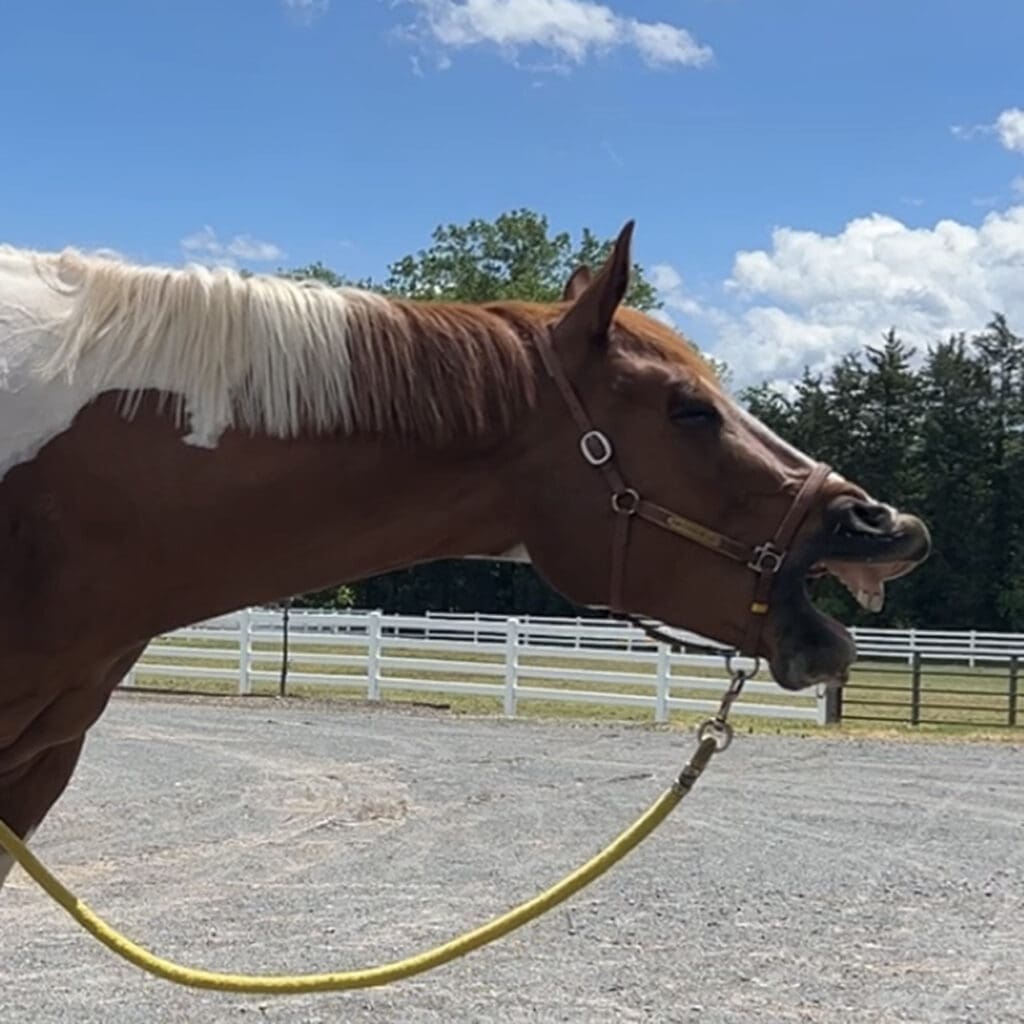
Many of us are familiar with what can happen to our range of motion when we sit at a desk all day long or do the same motion over and over again (like swinging a golf club or scrolling on our phones). Over time, our body tends to stay in the posture that we spend most of our time in and it can lose flexibility. This tendency is often referred to as Motor Sensory Amnesia (MSA). Our brain is really efficient, and it “forgets” how to move or sit or stand in certain ways when we don’t use those ways for a while because it determines that we must not need that ability anymore. Over time, that forgetting leads to a reduced range of motion and an habitual posture.
How Does This Relate to Horses?
The same thing can happen to horses. Most domestic horses don’t have the same space to roam as wild horses do, and they typically don’t have the opportunity to fully engage their bodies the same way they would in the wild. Plus, if they have a specific job to do, like dressage, or jumping, their body adapts to doing that job very well. But in the process of that adaptation, they can lose range of motion and develop postural patterns. We can also see the development of acquired laterality, or a strong preference for using a certain side of the body for an action. For example, a horse may prefer their left lead over their right. Or they may struggle with balancing on a circle to the right, but not to the left.
Healthy Horses Have Full Range of Motion
Healthy horses possess a full range of motion for their whole body and are able to balance better on both sides of their body. Many horse training methods are designed to help horses be more flexible and straighter while also developing the ability to equally bend through both sides of their bodies. These methods typically take years and can be frustrating for the horse and the rider.
Imagine if you were continually drilled to use your left hand to write when your strong preference was to use your right? You might improve your left-handed writing, but it could come at the cost of your emotional well being, due to the stress of constantly feeling forced to move against your preferences. Horses can feel the same way.
But what if you could help your horse develop better range of motion and balance without years of exhausting training?
This is where Equine Hanna Somatics comes in.
Equine Hanna Somatics exercises are based on a postural assessment of your horse, both at rest and moving. The exercises are matched to the preferences your horse shows when standing and moving. By supporting the horse’s preferences instead of working against them, we can actually help them expand their range of motion.
What Does a Typical Equine Hanna Somatics Session Look Like?
A typical session lasts about 45-60 minutes and includes:
- A postural assessment
- A physical palpation of the horse’s muscle tone
- A guided set of exercises that allows the horse to explore their range of motion
- Coaching for you to learn at least one exercise that you can do with your horse
- A written session report summarizing the exercises and recommendations
The horse participates in the process, which is why Equine Hanna Somatics educators always explain that we work WITH the horse, instead of doing something TO the horse. Because the horse is participating, the information from the exercises is utilized by the brain to shift postural patterns over time as it “remembers” that the body has more range of motion than it has been using.
How Long Does it Take To See Results?
Many horses demonstrate improved postural and movement patterns almost immediately, while others need more time to integrate the information received while doing the exercises. You can see examples below of how horses can shift their posture in response to the exercises.
Examples of Equine Hanna Somatics Results:
Example 1: This example shows a horse immediately before and immediately after a session. The horse’s spine improved in its balance in this single session.
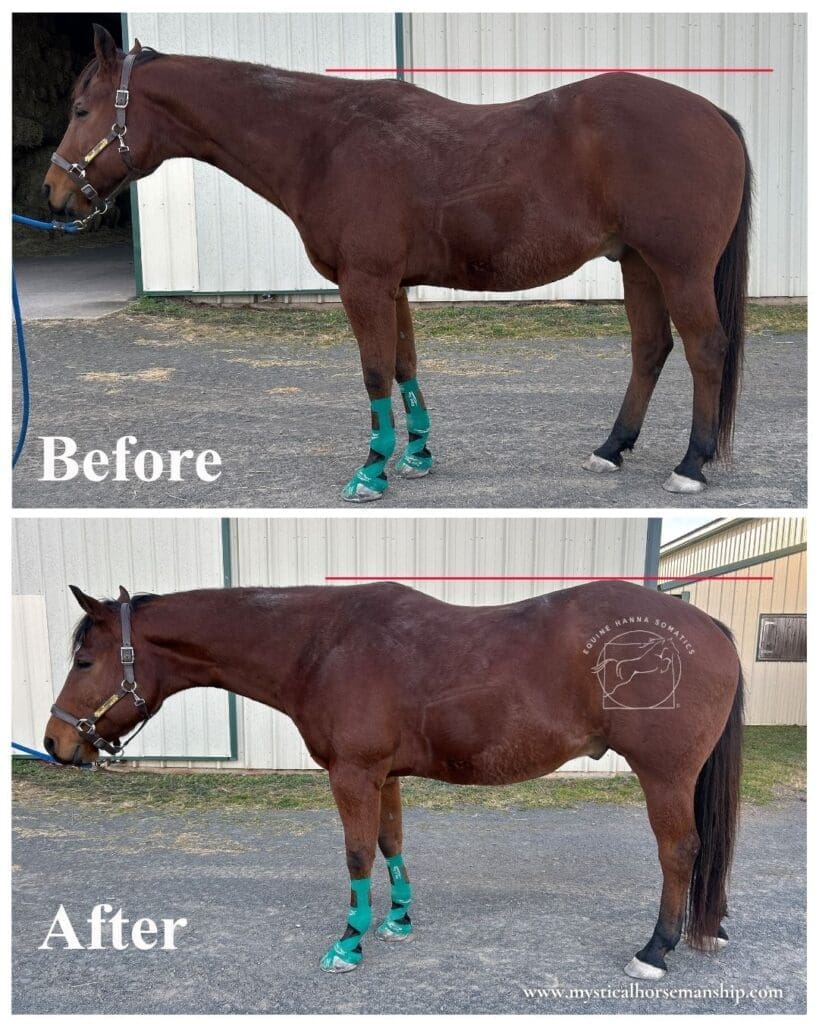
Example 2: This example shows the progression over a period of time. The first photo is immediately before a session focused on the horse’s head and neck. You can see that the horse has significant contraction on the right side of her head. The second photo shows the changes two days after the first session.
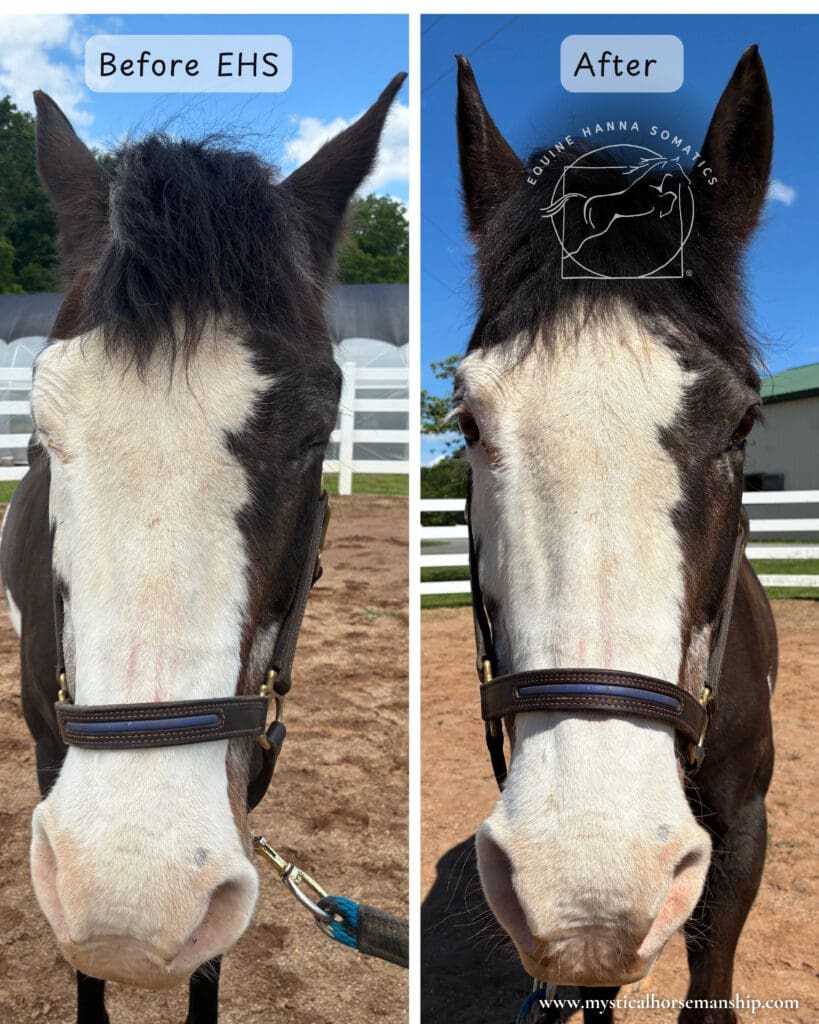
Example 3: This example shows a very interesting process. The first photo is immediately AFTER an Equine Hanna Somatics session. As you can see, the horse has a fairly significant c-shape to their spine. This c-shape did not change significantly from before the session to after the session. Instead, the spine dramatically straightened over time after the session. The horse received no other bodywork or Equine Hanna Somatics sessions between the days the photos were taken. The owner rode normally, and there were no changes in training or turnout. It is a beautiful example of how a horse can use the information gained during a single Equine Hanna Somatics session and use it to correct acquired laterality over time.
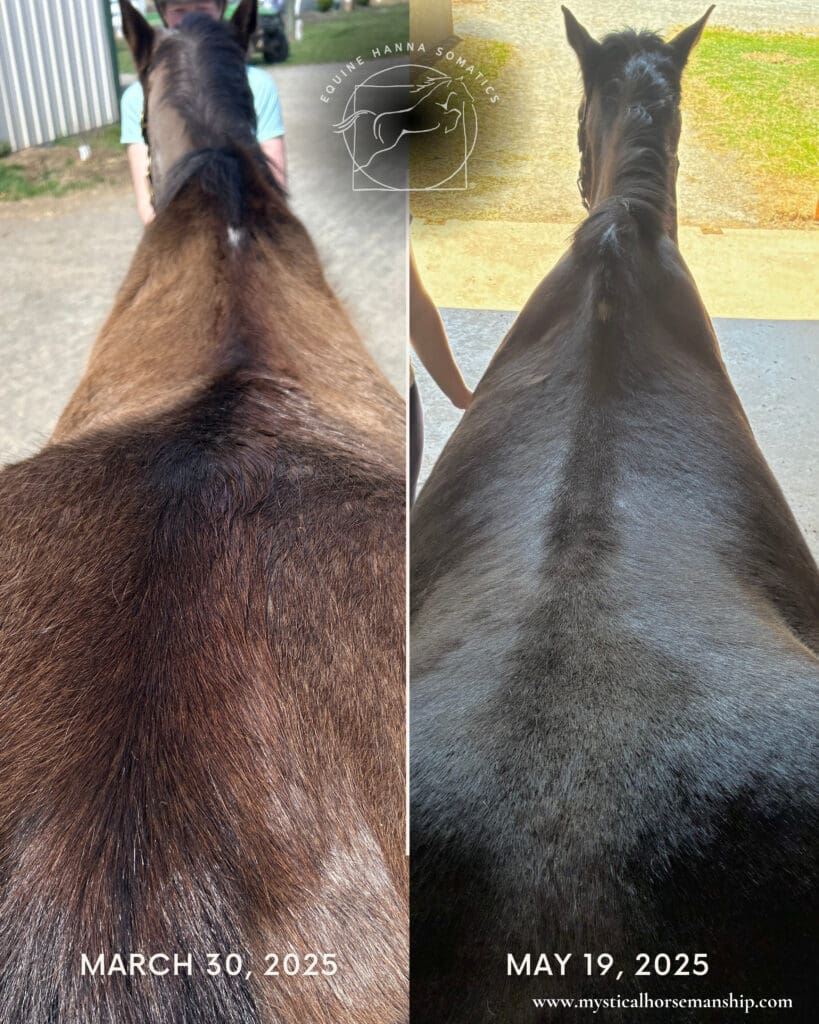
Benefits from Equine Hanna Somatics Sessions Can Include:
- Enhanced performance ability
- Increased range of motion
- Improved flexibility, suppleness, and straightness
- Injury prevention and career extension
- Relaxation and well-being
- Enhanced bonding with their human
The last benefit is particularly important.
When we help horses feel better, we help them feel better about being with us. Some horses can be skeptical about Equine Hanna Somatics exercises because they aren’t like anything else they’ve experienced with humans. But as they go through the exercises and feel the changes in their minds and bodies, they can develop an understanding that the exercises are helping them and so are the humans.
Over time, some horses even learn how to do the exercises by themselves, and their humans see them “practicing” on their own out in their pasture!
Learn Equine Hanna Somatics Exercises
The best part about Equine Hanna Somatics is that you can learn how to do many of the exercises with your horse! I always teach at least one of the exercises to my clients on the first visit, and I will add more as the client and the horse become familiar with the process.
You can even start learning how to do Equine Hannah Somatics exercises right away by purchasing this video.
(Note: This link is an affiliate link. If you choose to make a purchase after clicking this link, I receive a commission at no additional cost to you. Thank you for your support!)
Once you’ve watched the video and have had a chance to practice with your horse, you can always reach out to me to ask questions or book an in-person session.
Why I love Equine Hanna Somatics
It empowers the horse. There are many ways to work with horses and improve their well-being, but I love Equine Hanna Somatics because of how it works with the horse’s mind and body and empowers them to shape the way they stand and move.
It is accessible for anyone willing to learn. Between the video I linked above and sessions with Equine Hanna Somatics educators, equestrians can learn how to do many of the exercises with their horses. And for those who want to explore the exercises in more depth, professional level training is available.
It supports all types of horses, regardless of age, breed, discipline, and performance level. The Equine Hanna Somatics exercises can be used safely with younger and older horses, with all breeds and conformation types, for horses training and/or competing in all disciplines, and for horses at all levels of work, from retired to light work to advanced performance.
It complements a variety of bodywork methods. While Equine Hanna Somatics is technically not bodywork, it complements bodywork methods, as long as the bodywork and EHS are done on separate days to avoid overloading the horse’s nervous system. While every horse is different, I like to keep at least a week between bodywork sessions and EHS sessions to allow sufficient time for integration of the bodywork and the EHS exercises.
It can be combined with many training methods, especially those focused on honoring the horse’s capabilities. Equine Hanna Somatics gives both the horse and the human handler a wonderful opportunity to practice subtle communication when they do the exercises. That practice can translate into better communication during groundwork, liberty training, in-hand work, lungeing, driving, and under saddle work. EHS also mentally and physically supports the horse through mind and body integration so that they can utilize their best range of motion and be as engaged as possible during their training sessions.
Interested in Learning More?
If you are interested in learning more about Equine Hanna Somatics or booking a session, please get in touch.
You can also take a deeper dive by looking at the resources listed below:
- Somatics: Reawakening the Mind’s Control of Movement, Flexibility, and Health by Thomas Hanna
- Equine Hanna Somatics® (EHS) Education
- Equine Hanna Somatics BLOG
- Association For Hanna Somatic Education®, Inc.
- Pandiculation: The Comparative Phenomenon of Systematic Stretching
- Pandiculation vs. Stretching for Horses
- Laterality in Horse Training: Psychological and Physical Balance and Coordination and Strength Rather Than Straightness
June 20, 2025
